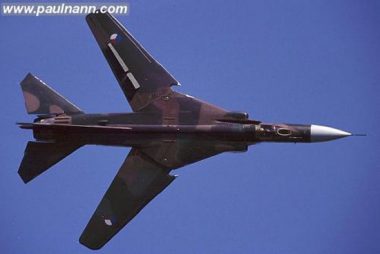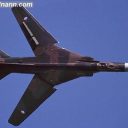MiG 23 ML Flight Model Performances Identification
LICENCE: This document has been created by J.M. LANGERON. All the values used to model the aircraft behavior have been computed by himself, as well as all performance charts presented here, based on data supplied by the people mentioned in the CREDITS. If you want to use these data, or part of it, please contact the author by personal message to TOPOLO on Check-six forum: (http://www.checksix-forums.com/) or ACIG (http://www.acig.info/).
CREDITS – I particularly wish to thanks:
Mr. Tom Cooper (ACIG.info) for the fact that he has been the founder and leader of the ACIG working group, strongly stimulating its members by his considerable knowledge of military aerospace, and especially the history of this aircraft.
Mr. Tomislav Mesaric for his patient and deep reading of the different drafts of this document and all the corrections, suggestions and comments he provided.
Table of Content
A. Purpose and scope. …………………………………………………………………………………………………………………………………………………… 2
B. General data Collection …………………………………………………………………………………………………………………………………………….. 2
C. Power Plant data ………………………………………………………………………………………………………………………………………………………. 4
D. Aerodynamic data …………………………………………………………………………………………………………………………………………………….. 5
E. Performance with X=72°. …………………………………………………………………………………………………………………………………………… 8
F. Performance with X=45° ………………………………………………………………………………………………………………………………………….. 15
G. Performance with X=16°. …………………………………………………………………………………………………………………………………………. 20
H. Combat Performance charts …………………………………………………………………………………………………………………………………….. 25
I. Annexes and Figures ……………………………………………………………………………………………………………………………………………….. 68
J. Bibliography. ………………………………………………………………………………………………………………………………………………………….. 71
A. Purpose and scope.
The object of this piece of work is to identify a Flight Model for the MiG-23ML (iz.23-12A, also known as MiG-23 MLA) powered by the Turmanski R35-F-300 turbojet engine that entered production in 1978 and is said being part of the second generation of MiG-23.
This identification consists mainly in defining Lift and Drag coefficient laws as well as Thrust laws.
These data thus allow to build a performance model, using templates and conventions common to a set of aircraft to be compared, and mainly inspired by the Performance appendix of the US NATOPS manuals. The performance charts are available at the end of this document.
Then, it becomes possible to compare the performances of the MiG-23ML to other documented aircraft, focusing on close air combat capabilities.
The main candidates for such a comparison are the MiG-23ML’s main opponents in the 1973-1988 period, opposing Israeli and Syrian Air Forces during the Yom Kippur War on one hand, and opposing Iranian and Iraqi Air Forces during the first Persian Gulf War (IPGW) on the other.
I will first focus on already documented Israel’s IAI Nesher and Mc Donnell Douglas F-4E blk41 and blk50 (without and with leading edge slats), and to the very close Iran’s F-4E blk54/57.
In addition, the MiG-21bis can be considered in order to illustrate the benefits of the MiG-23ML over the last evolution of its standard predecessor in most Arabic air forces.
Lastly, the IPGW conflict will drive to build a comparative study of the MiG-23ML versus the Iran’s F-14A (that I’ve still not identify a performance model allowing such comparison)
B. General data Collection
Document mis a jour le 04/04/2024
La suite :




Daldryk
15/01/2021 at 14:09Oui bien celui la, il ira direct dans mon garage à sa sortie.
TOPOLO
04/04/2024 at 15:43Avec l’aide d’un membre du forum ACIG qui a relu en détail ce document et clarifié / corrigé mes interprétations dus documents originaux (son russe est clairement meilleur que le mien…), j’ai pu mettre en ligne une version révisé de ce document.
Les modifications ne sont pas majeures, et impactent principalement la portance maximale (donc les vitesses minimales, les taux de virages et facteurs de charge instantanés…)
Le portrait de ce MiG-23ML reste grosso modo le même que celui dressé en 2019 (date de la première édition), mais il est maintenant un peu plus précis
https://drive.google.com/file/d/1NMtIlw0wF-LunYTD128br7x38W2ThhSY/view
Ghostrider
04/04/2024 at 21:12Je fais la mise a jour
Merci !!!!
TOPOLO
07/05/2024 at 07:04Encore du nouveau pour cet avion (toujours avec la même aide):
Les performances du MiG-23 ont été décrites pour des positions classiques de l’aile (flèche de 16°, 45° et 72°), mais il y a des raisons de penser que de meilleures performances en combat pourraient être obtenues avec une aile balayée dans une position « intermédiaire ».
Pour la dernière variante du MiG-23, le MiG-23MLD izd.23-18, de nombreux rapports présentent la position « optimale » de l’aile pour le comabt aérien comme étant environ 33°, mais aucun chiffre de performance ou même de résultats d’essais en vol n’a été trouvé pour étayer cette hypothèse.
L’objectif de cet article est d’estimer un modèle de vol pour un MiG-23ML (izd.23-12, izd.23-12A, izd.23-12B, izd.23-19, izd.23-22A ou izd.23-22B) avec les ailes en flèche dans cette position intermédiaire.
Le but n’est pas de prendre en compte les améliorations aérodynamiques appliquées à l’izd.23-18, mais plutôt d’explorer ce qu’un utilisateur « avancé » de la dernière version d’exportation du MiG-23 pourrait avoir entre les mains.
https://drive.google.com/file/d/1Gug8FVt2YqOdMM7I6YbktOxyZrWKc8ys/view